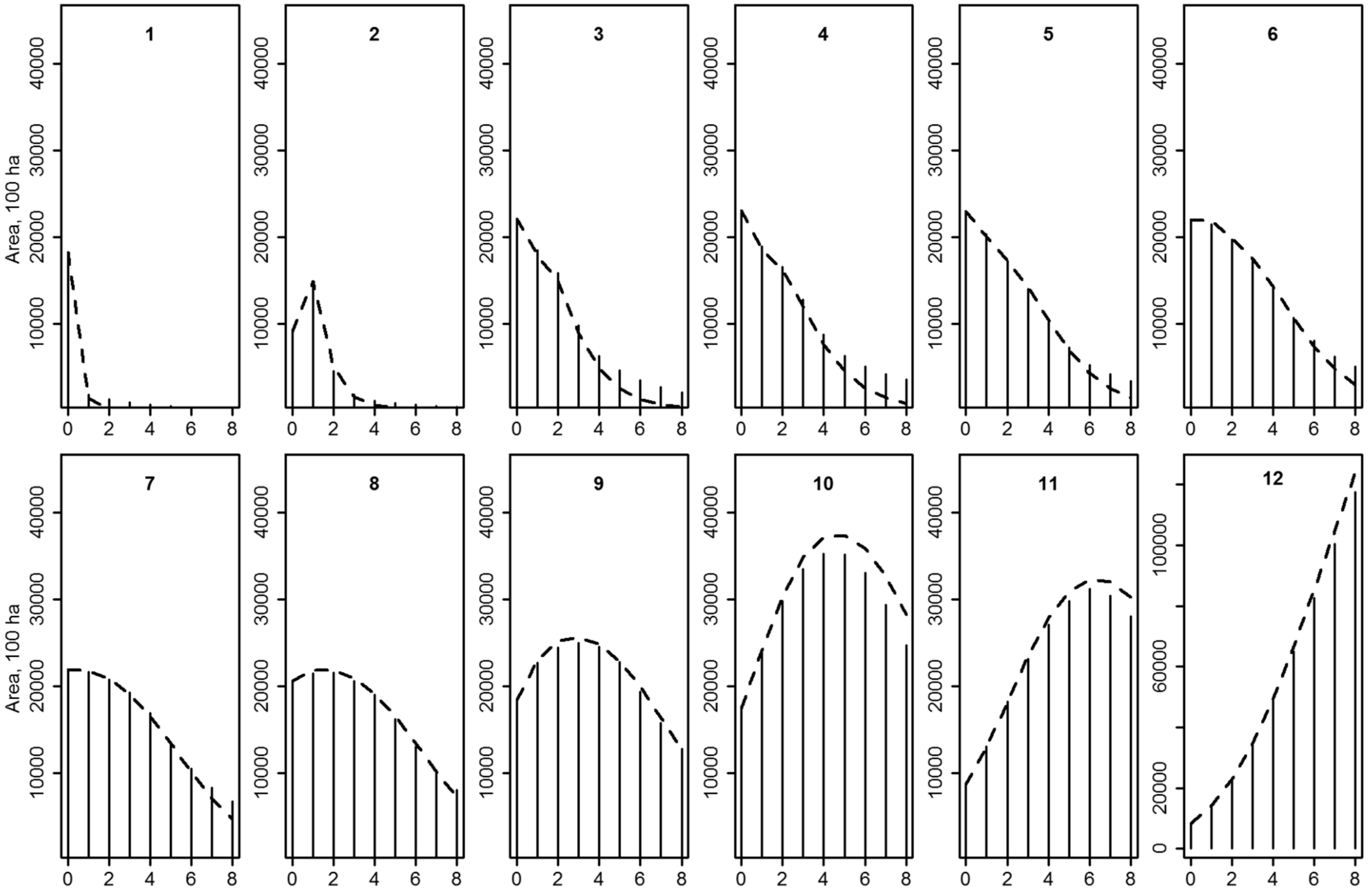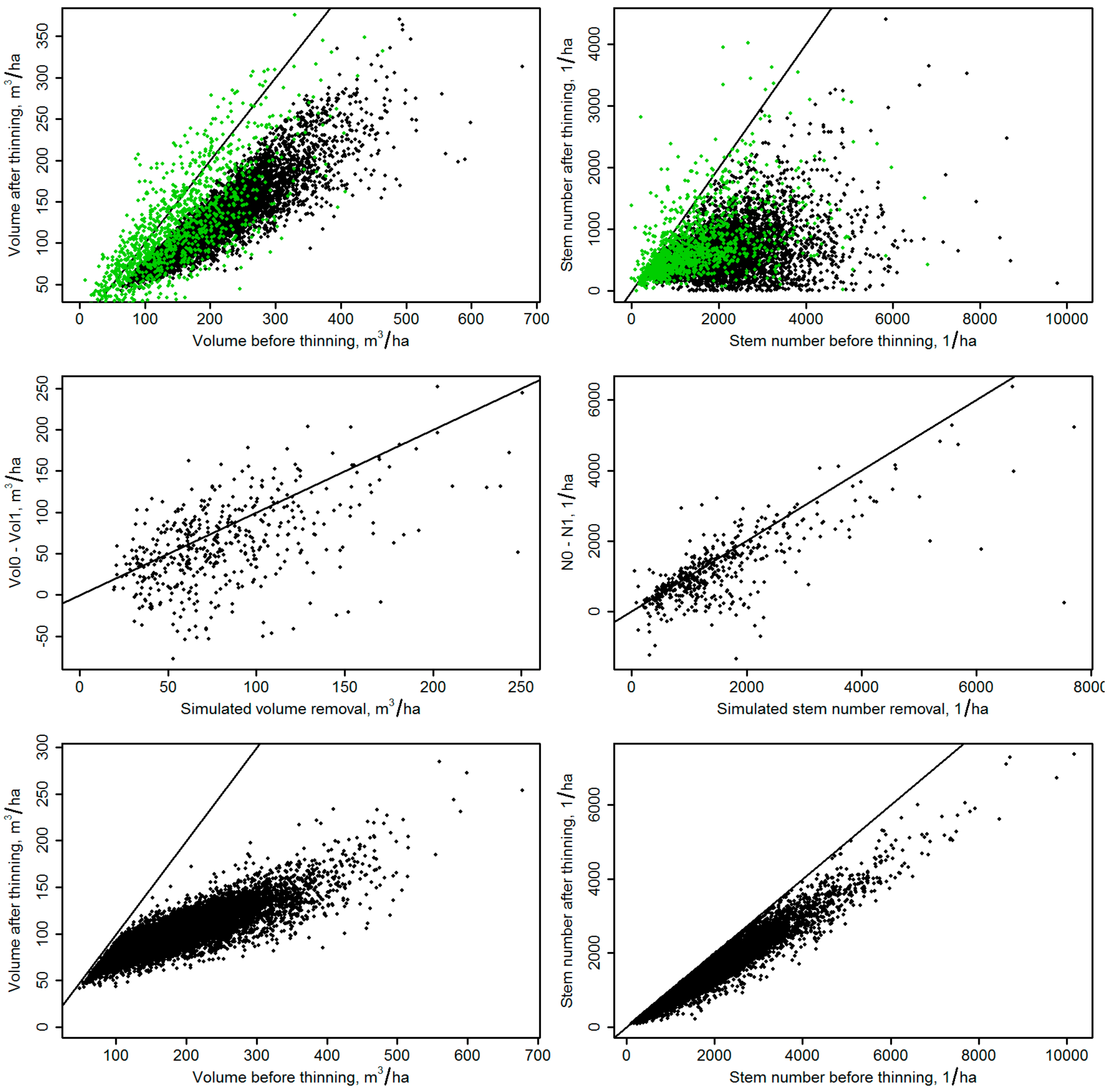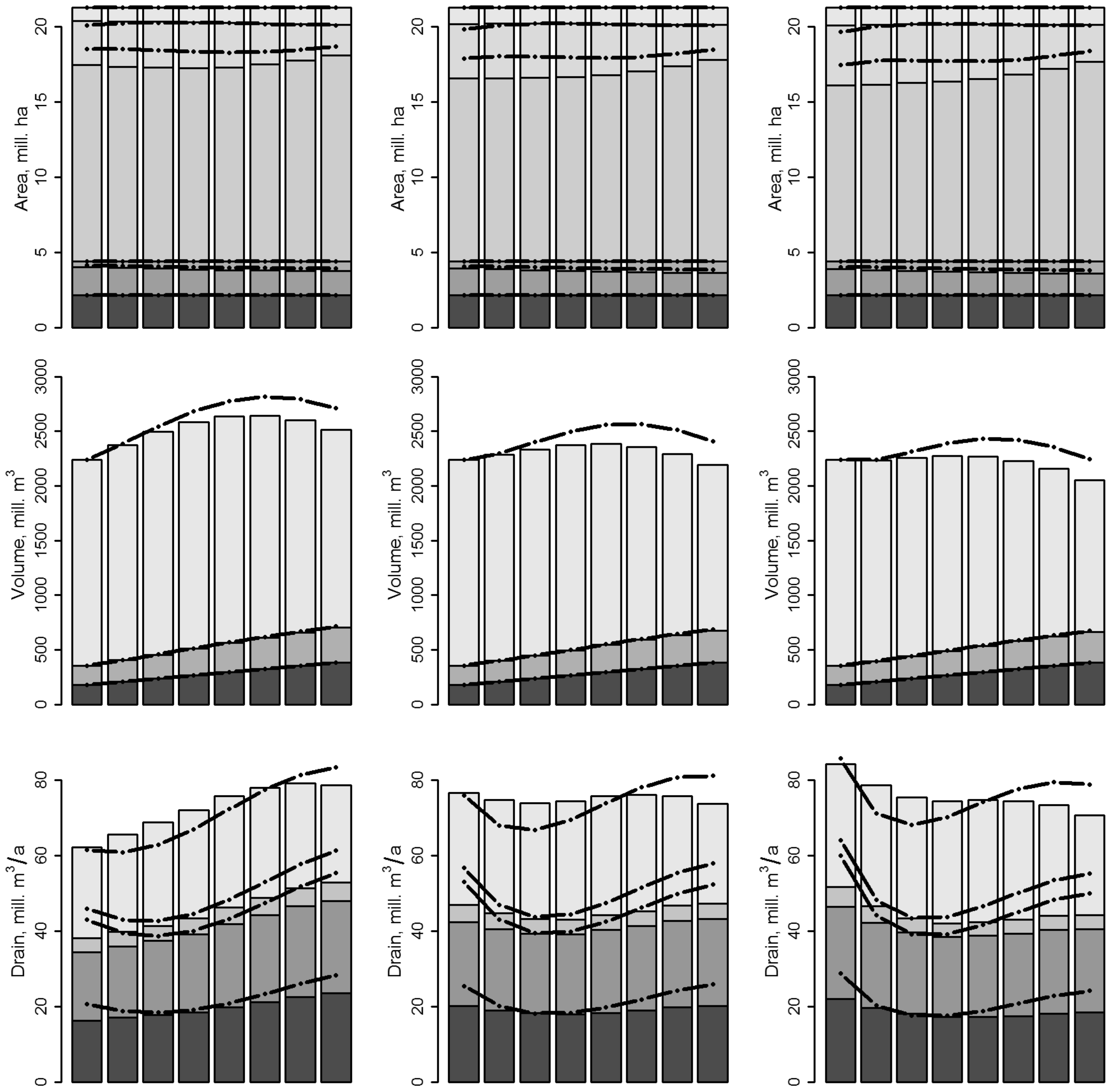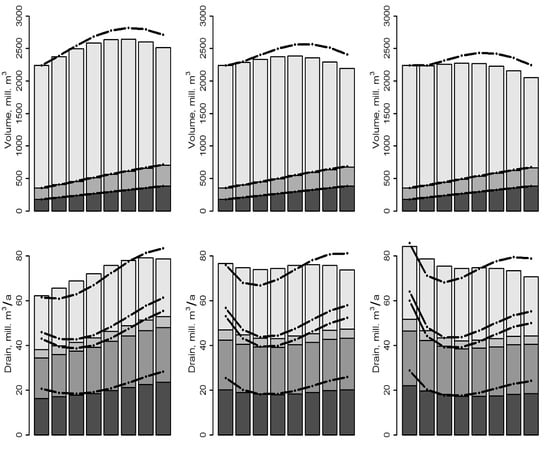A Markov Chain Model for Simulating Wood Supply from Any-Aged Forest Management Based on National Forest Inventory (NFI) Data
Abstract
1. Introduction
2. Materials and Methods
2.1. The Markov Chain Model
2.1.1. General Description
2.1.2. Application of the EFDM for the Simulations of Any-Aged Forest Management
2.2. Steps of the Analysis
- Preparing the initial forest inventory data and pairwise observations for modeling the transitions (Section 2.3);
- Parameterizing the EFDM model with respect to the initial state space, transition and activity probabilities, and output coefficients (Section 2.4);
- Running the EFDM with scenario assumptions specified in Section 2.5.
2.3. Forest Inventory Data
2.3.1. An Overview of Parameterizing the EFDM with the Input Data
- The initial state was determined based on the full NFI11 (or NFI10 in one validation analysis). The data processing involved the initial estimation (Section 2.3.2) and formatting the data for the EFDM (Section 2.4.1).
- Two alternative data sets were used to derive the pairwise observations to model the transitions due to natural processes. The data sets were permanent NFI10-11 and temporary NFI11 plots, which slightly differ in terms of estimating the pairwise observations, as detailed in Section 2.3.3 and Section 2.4.2 with respect to estimation and EFDM-specific formatting, respectively. The two plot types were used to derive two distinct sets of transition probabilities, which were switched as the input data when running the analyses, but the permanent and temporary plots were never merged when modeling the transitions. Notably, the transitions estimated based on both the permanent and temporary plot data included only growth and not potential reductions due to calamities or natural disturbances [32], for example. Including these effects is discussed in Section 4 and Section 5.
- A simulator was implemented to derive the pairwise observations from situations before and after thinning treatments. The thinnings took place in the beginning of each simulation period and the growth of the thinned forests in that period was simulated applying the transition probabilities of forests not managed. The forests affected by final fellings were forced to transit to the beginning of the even-aged rotation. The data processing involved the initial estimation (Section 2.3.3) and formatting the data for the EFDM (Section 2.4.2).
- The activity probabilities, which give the proportion of different types of forests to be managed, were defined in two steps with two assumptions. First, the initial allocation of the harvests to the different types of forests was assumed to follow either the proportion of harvests realized during the most recent five-year period (“business-as-usual allocation”, ABAU) or the proportion of forests that should be harvested strictly according to the instructions of forest management [41] (“schoolbook allocation”, ASB). Second, the final values for the activity probabilities of both the allocations were obtained by iteratively adjusting the initial probabilities to produce the harvesting levels aimed at in the future large-area scenarios. The data processing related to both the steps is explained in detail in Section 2.4.3 and Section 2.5.
- Output coefficients were prepared to translate the areas in different volume, age, and stem number classes to timber assortment and total volumes. The related steps are explained in Section 2.4.4.
2.3.2. Measurements and Estimation Principles of the NFI Data
2.3.3. Pairwise Observations
- Deriving the growth observations is explained separately for the two alternative data sets, namely (a) permanent and (b) temporary NFI plots:
- (a)
- Permanent NFI sample plots, which were matched between data sets with certainty and had no treatments between the two subsequent inventories, were identified from the data. The positive differences in the total volumes between NFI10 and NFI11 were recorded as the pairwise data.
- (b)
- Pairwise observations were derived from temporary NFI11 plots using the increment estimates. In the NFI, every seventh tree (continuously over plot clusters) is measured for diameter and height increment, from which a volume growth percent was estimated following Tomppo et al. [43]. Due to the low number of observations, the percent was estimated at the level of sampling regions and the percent computed for a sampling region was applied for all plots in the region. This percent was used to estimate the difference of volumes between the two subsequent inventories for the plots without treatments, i.e., the pairwise observations were obtained as the difference between the observed volume and that deducted by the estimated growth.
- To determine transitions due to management by thinning treatments, a plot-level simulator was implemented to assess the proportion of the total and assortment volume to be removed in future thinning treatments. The NFI11 plots were used as the input data. The simulator determined the thinning removal following two types of instructions:
- (a)
- A thinning from below corresponding to traditionally applied instructions for forest management [41] was simulated according to thinning curves downloaded from the repository of the SIMO software (Simosol Py, Riihimäki, Finland, [44]). The curves predict the thinning limit and remaining basal area as the function of tree species, site type and dominant height (estimated as mean stand height +1.75 m [45]). The lower curves of two available thinning intensity levels were used and the harvesting removal was determined as the difference between the thinning need and remaining basal area.
- (b)
- A thinning from above was simulated by predicting the remaining basal area using the plot-level forest attributes as predictors of Equation (2) of Pukkala et al. [46]. The thinning intensity is determined in terms of interest rate used as a predictor of the aforementioned equation. We used the curves corresponding to an interest rate of 3% and determined the harvesting removal as the difference between the initial and remaining basal area.
2.4. Parameterization of the Markov Model
2.4.1. State Space
- Known land-use restrictions: FAWS, FRAWS, FNAWS
- Forest ownership: private, public + other (cf. [42]).
- Site fertility: altogether, five categories corresponding to four taxation classes traditionally used in Finland + fifth class including all poorly productive forest land.
- Dominant species: pine, spruce, deciduous trees.
- In the input data for the simulations, every plot representing even-aged forest had a value of 0 as the stem number class and the values of age and volume ranged according Appendix A. Every plot representing uneven-aged forest had a value of 0 as the age class and the values of stem number and volume ranged according to Appendix A.
- In the input data for modeling the transition probabilities, the set of plots with pairwise observations was duplicated. Thus, every plot was included twice with either the age or stem number class set as 0, i.e., the data to model the transitions of both Age-Vol or N-Vol were always the same except for the variable combination.
2.4.2. Transition Probabilities
2.4.3. Activity Probabilities
2.4.4. Output Coefficients
2.5. Harvesting Scenarios Used in the Simulations of Any-Aged Forest Management
3. Results
3.1. Effects of the Parameterization of the EFDM on the Projections
3.2. Results of the Scenario Analyses
4. Discussion
4.1. Parameterization of the Markov Model for the Simulations of Any-Aged Forest Management
4.2. On the Use of the EFDM Approach for Projecting Future Wood Supply
4.3. Recommendations for Further Research
5. Conclusions
Acknowledgments
Author Contributions
Conflicts of Interest
Appendix A
| Volume Classes 1 | Age Classes 1 |
|---|---|
| 1. (∞, 0.0000) | 1. (∞, 0) |
| 2. (0.0000, 10.5884) | 2. (0, 5) |
| 3. (10.5884, 29.8618) | 3. (5, 10) |
| 4. (29.8618, 51.3846) | 4. (10, 15) |
| 5. (51.3846, 73.6844) | 5. (15, 20) |
| 6. (73.6844, 96.5440) | 6. (20, 25) |
| 7. (96.5440, 122.8744) | 7. (25, 30) |
| 8. (122.8744, 153.2864) | 8. (30, 35) |
| 9. (153.2864, 191.3348) | 9. (35, 40) |
| 10. (191.3348, 248.0352) | 10. (40, 45) |
| 11. (248.0352, 303.3532) | 11. (45, 50) |
| 12. (303.3532, ∞) | 12. (50, 55) |
| 13. (55, 60) | |
| Stem number classes 1 | 14. (60, 65) |
| 1. (∞, 0.0000) | 15. (65, 70) |
| 2. (0.0000, 69.8725) | 16. (70, 75) |
| 3. (69.8725, 330.6332) | 17. (75, 80) |
| 4. (330.6332, 509.0106) | 18. (80, 85) |
| 5. (509.0106, 676.9061) | 19. (85, 90) |
| 6. (676.9061, 875.1651) | 20. (90, 95) |
| 7. (875.1651, 1108.6395) | 21. (95, 100) |
| 8. (1108.6395, 1384.8279) | 22. (100, 105) |
| 9. (1384.8279, 1754.0609) | 23. (105, 110) |
| 10. (1754.0609, 2398.5651) | 24. (110, 115) |
| 11. (2398.5651, 2975.8412) | 25. (115, 120) |
| 12. (2975.8412, ∞) | 26. (120, ∞) |
References
- Hanssen, S.V.; Duden, A.S.; Junginger, M.; Dale, V.H.; Hilst, F. Wood pellets, what else? Greenhouse gas parity times of European electricity from wood pellets produced in the south-eastern United States using different softwood feedstocks. Glob. Chang. Biol. Bioenergy 2017. [Google Scholar] [CrossRef]
- Johnston, C.M.; van Kooten, G.C. Global trade impacts of increasing Europe’s bioenergy demand. J. For. Econ. 2016, 23, 27–44. [Google Scholar] [CrossRef]
- Raunikar, R.; Buongiorno, J.; Turner, J.A.; Zhu, S. Global outlook for wood and forests with the bioenergy demand implied by scenarios of the Intergovernmental Panel on Climate Change. For. Pol. Econ. 2010, 12, 48–56. [Google Scholar] [CrossRef]
- Börjesson, P.; Hansson, J.; Berndes, G. Future demand for forest-based biomass for energy purposes in Sweden. For. Ecol. Manag. 2017, 383, 17–26. [Google Scholar] [CrossRef]
- Alberdi, I.; Michalak, R.; Fischer, C.; Gasparini, P.; Brändli, U.B.; Tomter, S.M.; Kuliesis, A.; Snorrason, A.; Redmond, J.; Hernández, L.; et al. Towards harmonized assessment of European forest availability for wood supply in Europe. For. Pol. Econ. 2016, 70, 20–29. [Google Scholar] [CrossRef]
- Fischer, C.; Gasparini, P.; Nylander, M.; Redmond, J.; Hernandez, L.; Brändli, U.B.; Pastor, A.; Rizzo, M.; Alberdi, I. Joining criteria for harmonizing European Forest Available for Wood Supply estimates. Case studies from National Forest Inventories. Forests 2016, 7, 104. [Google Scholar] [CrossRef]
- Fürstenau, C.; Badek, F.W.; Lasch, P.; Lexer, M.J.; Linder, M.; Mohr, P.; Suckow, F. Multiple-use forest management in consideration of climate change and the interests of stakeholder groups. Eur. J. For. Res. 2007, 126, 225–239. [Google Scholar] [CrossRef]
- Diaci, J.; Kerr, G.; O’Hara, K. Twenty-first century forestry: Integrating ecologically based, uneven-aged silviculture with increased demands on forests. Forestry 2011, 84, 463–465. [Google Scholar] [CrossRef]
- Pukkala, T. Which type of forest management provides most ecosystem services? For. Ecosyst. 2016, 3, 9. [Google Scholar] [CrossRef]
- Barreiro, S.; Schelhaas, M. J.; Kändler, G.; Antón-Fernández, C.; Colin, A.; Bontemps, J. D.; Alberdi, I.; Condés, S.; Dumitru, M.; Ferezliev, A.; et al. Overview of methods and tools for evaluating future woody biomass availability in European countries. Ann. For. Sci. 2016, 73, 823–837. [Google Scholar] [CrossRef]
- Verkerk, P.J.; Anttila, P.; Eggers, J.; Lindner, M.; Asikainen, A. The realisable potential supply of woody biomass from forests in the European Union. For. Ecol. Manag. 2011, 261, 2007–2015. [Google Scholar] [CrossRef]
- Bentsen, N.S.; Felby, C. Biomass for energy in the European Union—A review of bioenergy resource assessments. Biotechnol. Biofuels 2012, 5, 25. [Google Scholar] [CrossRef] [PubMed]
- Rettenmaier, N.; Köppen, S.; Gärtner, S.O.; Reinhardt, G.A. Life cycle assessment of selected future energy crops for Europe. Biofuels Bioprod. Biorefin. 2010, 4, 620–636. [Google Scholar] [CrossRef]
- Mantau, U.; Gschwantner, T.; Paletto, A.; Mayr, M.L.; Blanke, C.; Strukova, E.; Avdagic, A.; Camin, P.; Thivolle-Cazat, A.; Döring, P.; et al. From inventory to consumer biomass availability—The ITOC model. Ann. For. Sci. 2016, 73, 885–894. [Google Scholar] [CrossRef]
- Monserud, R.A.; Sterba, H. A basal area increment model for individual trees growing in even-and uneven-aged forest stands in Austria. For. Ecol. Manag. 1996, 80, 57–80. [Google Scholar] [CrossRef]
- Siitonen, M.; Anola-Pukkila, A.; Haara, A.; Härkönen, K.; Redsven, V.; Salminen, O.; Suokas, A. (Eds.) MELA Handbook, 2000 ed.; The Finnish Forest Research Institute: Helsinki, Finland, 2001; p. 498. Available online: http://mela2.metla.fi/mela/julkaisut/oppaat/mela2000.pdf (accessed on 5 July 2017).
- Wikström, P.; Edenius, L.; Elfving, B.; Eriksson, L.O.; Lämås, T.; Sonesson, J.; Öhman, K.; Wallerman, J.; Waller, C.; Klintebäck, F. The Heureka forestry decision support system: An overview. Math. Comp. For. Nat. Res. Sci. 2011, 3, 87–94. [Google Scholar]
- Bösch, M.; Elsasser, P.; Rock, J.; Rüter, S.; Weimar, H.; Dieter, M. Costs and carbon sequestration potential of alternative forest management measures in Germany. For. Pol. Econ. 2017, 78, 88–97. [Google Scholar] [CrossRef]
- Nabuurs, G.J.; Schelhaas, M.J.; Pussinen, A. Validation of the European Forest Information Scenario Model (EFISCEN) and a projection of Finnish forests. Silva Fenn. 2000, 34, 167–179. [Google Scholar] [CrossRef]
- Thürig, E.; Schelhaas, M.J. Evaluation of a large-scale forest scenario model in heterogeneous forests: A case study for Switzerland. Can. J. For. Res. 2006, 36, 671–683. [Google Scholar] [CrossRef]
- Eriksson, L.O.; Sallnäs, O.; Ståhl, G. Forest certification and Swedish wood supply. For. Pol. Econ. 2007, 9, 452–463. [Google Scholar] [CrossRef]
- Nilsson, S.; Sallnäs, O.; Duinker, P. Future Forest Resources of Western and Eastern Europe; A Report on the IIASA Forest Study; The Parthenon Publishing Group: Casterton Hall, Camforth, UK, 1992; p. 496. Available online: http://pure.iiasa.ac.at/3589/1/XB-92-001.pdf (accessed on 5 July 2017).
- Sallnäs, O. A Matrix Growth Model of the Swedish Forest; Studia Forestalia Suecica; Swedish University of Agricultural Sciences, Faculty of Forestry: Uppsala, Sweden, 1990; p. 23. Available online: http://urn.kb.se/resolve?urn=urn:nbn:se:slu:epsilon-9-13 (accessed on 5 July 2017).
- Usher, M.B. A matrix approach to the management of renewable resources, with special reference to selection forests. J. Appl. Ecol. 1966, 3, 355–367. [Google Scholar] [CrossRef]
- Usher, M.B. A matrix model for forest management. Biometrics 1969, 25, 309–315. [Google Scholar] [CrossRef]
- Usher, M.B. Markovian approaches to ecological succession. J. Anim. Ecol. 1979, 48, 413–426. [Google Scholar] [CrossRef]
- Nabuurs, G.J.; Päivinen, R.; Schantz, H. Sustainable management regimes for Europe’s forests—A projection with EFISCEN until 2050. For. Pol. Econ. 2001, 3, 155–173. [Google Scholar] [CrossRef]
- Buongiorno, J.; Peyron, J.L.; Houllier, F.; Bruciamacchie, M. Growth and management of mixed-species, uneven-aged forests in the French Jura: Implications for economic returns and tree diversity. For. Sci. 1995, 41, 397–429. [Google Scholar]
- Virgilietti, P.; Buongiorno, J. Modeling forest growth with management data: A matrix approach for the Italian Alps. Silva Fenn. 1997, 31, 27–42. [Google Scholar] [CrossRef]
- Bollandsås, O.M.; Buongiorno, J.; Gobakken, T. Predicting the growth of stands of trees of mixed species and size: A matrix model for Norway. Scand. J. For. Res. 2008, 23, 167–178. [Google Scholar] [CrossRef]
- Packalen, T.; Sallnäs, O.; Sirkiä, S.; Korhonen, K.; Salminen, O.; Vidal, C.; Robert, N.; Colin, A.; Belouard, T.; Schadauer, K.; et al. The European Forestry Dynamics Model: Concept, Design and Results of First Case Studies; JRC Science and Policy Reports; EUR 27004; Publications Office of the European Union: Luxembourg, 2014; Volume 93450, p. 20. [Google Scholar] [CrossRef]
- Sallnäs, O.; Berger, A.; Räty, M.; Trubins, R. An area-based matrix model for uneven-aged forests. Forests 2015, 6, 1500–1515. [Google Scholar] [CrossRef]
- Haight, R.G. Evaluating the efficiency of even-aged and uneven-aged stand management. For. Sci. 1987, 33, 116–134. [Google Scholar]
- Haight, R.G.; Monserud, R.A. Optimizing any-aged management of mixed-species stands. I. Performance of a coordinate-search process. Can. J. For. Res. 1990, 20, 15–25. [Google Scholar] [CrossRef]
- Haight, R.G.; Monserud, R.A. Optimizing any-aged management of mixed-species stands: II. Effects of decision criteria. For. Sci. 1990, 36, 125–144. [Google Scholar]
- Pukkala, T.; Lähde, E.; Laiho, O. Optimizing any-aged management of mixed boreal forest under residual basal area constraints. J. For. Res. 2014, 25, 627–636. [Google Scholar] [CrossRef]
- Sirkiä, S. Methodology and System Design—Some Mathematics behind EFDM. Appendix 1 in Developing and Testing a Prototype for European Forestry Dynamics Model (EFDM); Anon.; Specific Contract 10 Report, Framework Contract for the Provision of Forest Data and Services in Support to the European Forest Data Centre; Reference: 2007/ S 194–235358 of 09/10/2007; Available online: https://webgate.ec.europa.eu/CITnet/stash/projects/FISE/repos/efdm/browse/documents/EFDMinstructions/Seija_Mathematics_behind_EFDM.pdf (accessed on 5 July 2017).
- R Core Team. R: A Language and Environment for Statistical Computing; R Foundation for Statistical Computing: Vienna, Austria, 2016; Available online: https://www.R-project.org/ (accessed on 5 July 2017).
- Forest Information System for Europe. EFDM. Software Repository. Available online: https://webgate.ec.europa.eu/CITnet/stash/projects/FISE/repos/efdm/browse (accessed on 5 July 2017).
- Anon. European Forestry Dynamics Model; MediaWiki. Available online: https://forestwiki.jrc.ec.europa.eu/efdm/index.php/Main_Page (accessed on 5 July 2017).
- Yrjölä, T. Forest Management Guidelines and Practices in Finland, Sweden and Norway; Internal Report; European Forest Institute: Joensuu, Finland, 2002; Volume 11, Available online: http://www.efi.int/files/attachments/publications/ir_11.pdf (accessed on 5 July 2017).
- Korhonen, K.T. Finland. In National Forest Inventories—Assessment of Wood Availability and Use; Vidal, C., Alberdi, I.A., Hernández Mateo, L., Redmond, J.J., Eds.; Springer International Publishing: Cham, Switzerland, 2016; pp. 369–384. [Google Scholar]
- Tomppo, E.; Heikkinen, J.; Henttonen, H.M.; Ihalainen, A.; Katila, M.; Mäkelä, H.; Tuomainen, T.; Vainikainen, N. Designing and Conducting A Forest Inventory—Case: 9th National Forest Inventory of Finland; Managing Forest Ecosystems, Springer: Dordrecht, The Netherlands, 2011; Volume 21, p. 270. [Google Scholar]
- Simosol Oy. Thinning Limit Model Library—Source File; SIMO—Adaptable Simulation and Optimization, Simosol Oy: Riihimäki, Finland, 2007; Available online: http://svn.simo-project.org/simo/trunk/src/models/Finland/c/Thinningmodel Library.c (accessed on 5 July 2017).
- Ojansuu, R.; Halinen, M.; Härkönen, K. Metsätalouden suunnittelujärjestelmän virhelähteet männyn ensiharvennuskypsyyden määrityksessä. Metsätieteen Aikakauskirja 2002, 3, 441–457. [Google Scholar] [CrossRef]
- Pukkala, T.; Lähde, E.; Laiho, O. Which trees should be removed in thinning treatments? For. Ecosyst. 2015, 2, 32. [Google Scholar] [CrossRef]
- Ministry of Agriculture and Forestry. National Forest Strategy 2025—Government Resolution of 12 February 2015; Ministry of Agriculture and Forestry: Helsinki, Finland, 2015; Volume 6, p. 56. Available online: http://mmm.fi/documents/1410837/1504826/National+Forest+Strategy+2025/197e0aa4-2b6c-426c-b0d0-f8b0f277f332 (accessed on 5 July 2017).
- Peltola, A. (Ed.) Finnish Statistical Yearbook of Forestry 2014; Finnish Forest Research Institute, Tammerprint Oy: Tampere, Finland, 2014; p. 450. [Google Scholar]
- Liang, J.; Picard, N. Matrix model of forest dynamics: An overview and outlook. For. Sci. 2013, 59, 359–378. [Google Scholar] [CrossRef]
- Jonsson, R.; Rinaldi, F.; Räty, M.; Sallnäs, O. Integrating forest-based industry and forest resource modeling. iFor. Biogeosci. For. 2016, 9, 743–750. [Google Scholar] [CrossRef]
- Mehtätalo, L.; Peltola, H.; Kilpeläinen, A.; Ikonen, V.P. The response of basal area growth of Scots pine to thinning: A longitudinal analysis of tree-specific series using a nonlinear mixed-effects model. For. Sci. 2014, 60, 636–644. [Google Scholar] [CrossRef]
- Hynynen, J.; Ojansuu, R. Impact of plot size on individual-tree competition measures for growth and yield simulators. Can. J. For. Res. 2003, 33, 455–465. [Google Scholar] [CrossRef]
- Heinonen, T.; Pukkala, T.; Mehtätalo, L.; Asikainen, A.; Kangas, J.; Peltola, H. Scenario analyses for the effects of harvesting intensity on development of forest resources, timber supply, carbon balance and biodiversity of Finnish forestry. For. Pol. Econ. 2017, 80, 80–98. [Google Scholar] [CrossRef]
- Hynynen, J.; Salminen, H.; Ahtikoski, A.; Huuskonen, S.; Ojansuu, R.; Siipilehto, J.; Lehtonen, M.; Eerikäinen, K. Long-term impacts of forest management on biomass supply and forest resource development: A scenario analysis for Finland. Eur. J. For. Res. 2015, 134, 415–431. [Google Scholar] [CrossRef]
- Pussinen, A.; Schelhaas, M.J.; Verkaik, E.; Heikkinen, E.; Liski, J.; Karjalainen, T.; Päivinen, R.; Nabuurs, G.J. Manual for the European Forest Information Scenario Model (EFISCEN 2.0); Internal Report; European Forest Institute: Joensuu, Finland, 2001; Volume 5, Available online: http://www.efi.int/files/attachments/publications/ir_05.pdf (accessed on 5 July 2017).
- Henttonen, H.M.; Nöjd, P.; Mäkinen, H. Environment-induced growth chances in the Finnish forests during 1971–2010—An analysis based on National Forest Inventory. For. Ecol. Manag. 2017, 386, 22–36. [Google Scholar] [CrossRef]







© 2017 by the authors. Licensee MDPI, Basel, Switzerland. This article is an open access article distributed under the terms and conditions of the Creative Commons Attribution (CC BY) license (http://creativecommons.org/licenses/by/4.0/).
Share and Cite
Vauhkonen, J.; Packalen, T. A Markov Chain Model for Simulating Wood Supply from Any-Aged Forest Management Based on National Forest Inventory (NFI) Data. Forests 2017, 8, 307. https://doi.org/10.3390/f8090307
Vauhkonen J, Packalen T. A Markov Chain Model for Simulating Wood Supply from Any-Aged Forest Management Based on National Forest Inventory (NFI) Data. Forests. 2017; 8(9):307. https://doi.org/10.3390/f8090307
Chicago/Turabian StyleVauhkonen, Jari, and Tuula Packalen. 2017. "A Markov Chain Model for Simulating Wood Supply from Any-Aged Forest Management Based on National Forest Inventory (NFI) Data" Forests 8, no. 9: 307. https://doi.org/10.3390/f8090307
APA StyleVauhkonen, J., & Packalen, T. (2017). A Markov Chain Model for Simulating Wood Supply from Any-Aged Forest Management Based on National Forest Inventory (NFI) Data. Forests, 8(9), 307. https://doi.org/10.3390/f8090307






